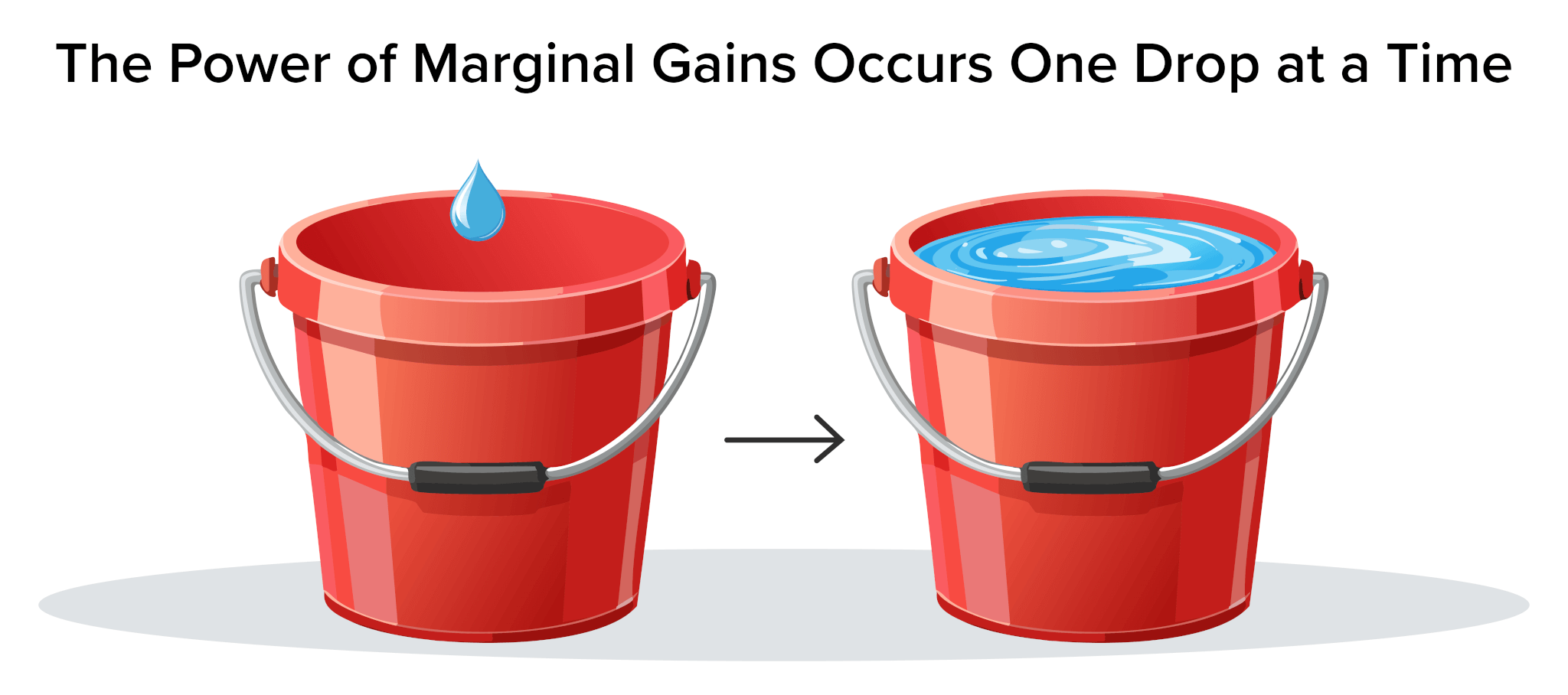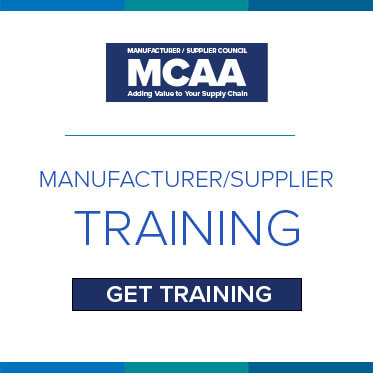
For mechanical contractors, staying competitive is a constant battle. But that doesn’t mean you need to make big changes that take a lot of time, effort, and money—it’s about making small, steady improvements over time in processes and people that add up to remarkable results. Focusing on marginal gains and cumulative learning offers a practical way to boost efficiency, reduce risks, and retain top talent—all while building a smarter and more capable workforce.
Marginal Gains
A single drop of water is pretty insignificant, but a consistent drip will fill a bucket over time. This principle of marginal gains—popularized by Sir Dave Brailsford in his transformation of British cycling—focuses on making one-percent improvements to achieve significant overall results.1 One percent may not seem like much, but over the course of one year it results in a staggering 3,678-percent improvement. Brailsford coined this phenomenon as “the aggregation of marginal gains.”2
Read about Brailsford’s coaching philosophy here: https://jamesclear.com/marginal-gains.
Author James Clear explains the cumulative effect of marginal gains here: https://jamesclear.com/continuous-improvement
What Is Cumulative Learning?
In the training world, the aggregation of marginal gains is called “cumulative learning”—that is, people learn best when they layer new information on what they already know and have opportunities to apply it.3
See the research behind this concept here: https://link.springer.com/book/10.1007/978-3-030-27005-6
Without a commitment to this type of learning, workers become stagnant in their skills and knowledge, hindering innovation and adaptability. They also become complacent in their safety practices, leading to more frequent incidents. Stagnation and complacency demolish motivation, heighten disengagement, and, ultimately, result in turnover as employees seek opportunities for advancement elsewhere. Employers are not only impacted by the costs of turnover,4 but they also lose valuable institutional knowledge and expertise.5
Learn more about the costs of low performers to your business: https://therscfirm.com/the-real-cost-of-low-performers-on-your-bottom-line/
Franz Belot writes about this on Tyfoom’s website: https://www.tyfoom.com/blog/knowledge-transfer-making-sure-expertise-and-skill-isnt-lost-when-retirees-leave-the-workforce/
Why Cumulative Learning Matters
The principles of marginal gains can be applied to daily learning to drive continuous improvement by the following approach:
- Setting clear, incremental goals. Break down larger objectives into small, manageable goals. This not only makes progress more tangible and less overwhelming mentally, but also provides a mathematical certainty of success.
- Focusing on process over outcome. Emphasize the importance of the process rather than just short-cutting to an unsustainable (and likely unattainable) result. By concentrating on improving daily practices and routines, the desired outcomes will follow naturally. This shift in focus helps maintain motivation and reduces the pressure associated with ambitious goals.6See The 4 Disciplines of Execution by McChesney and colleagues: https://www.simonandschuster.com/books/The-4-Disciplines-of-Execution-Revised-and-Updated/Chris-McChesney/9781982156985
- Regularly reviewing and adjusting. In aviation, for every one degree off course, the plane will miss its targeted landing spot by 92 feet per mile flown, equating to a staggering 500-mile difference after one hour of flight time.7 Sam DiGiovanna writes about this idea on the Lexipol website: https://www.lexipol.com/resources/blog/one-degree-off-course-policies-and-course-correction/.
Regular course correction is essential to stay on target and reach the projected goal. Consistent progress tracking allows for continual adjustments, ensuring the team stays on track for achieving any goal.8Course correction is one of the four disciplines of execution from McChesney and colleagues; read more here: https://www.franklincovey.com/the-4-disciplines/discipline-3-scoreboard/ - Embracing a growth mindset. The successful stay curious. Daily learning cultivates a mindset that values improvement. The belief that abilities and skills can be developed through effort and perseverance encourages adaptability and resilience to face challenges head-on.9 Learn more about the benefits of being curious in this article in Forbes online: https://www.forbes.com/councils/forbesagencycouncil/2023/05/15/activate-your-curiosity-why-leaders-must-stay-curious/
Building a More Efficient Workforce
Cumulative learning provides practical ways to strengthen teams and improve operations. Here’s how to make these strategies work:
- Personalize learning. Training should be relevant to different roles in a company. Personalized training is immediately applicable, increasing employees’ long-term engagement and knowledge retention. It also helps new hires become more familiar in their specific jobs so they can be better, safer, and faster.
- Incorporate microlearning. Microlearning, as embraced by Tyfoom’s short educational videos, delivers content in small, bite-sized pieces and fits in the flow of work. Concepts are broken into small chunks that build on each other and gradually gain in complexity. Microlearning allows employees to absorb and apply new information without feeling overwhelmed.
- Think mobile. Mobile-first platforms give employees access to lessons on devices in the flow of work, making learning a seamless part of their day.
- Encourage peer learning. Social learning through peer collaboration and gamified elements—like leaderboards, badges, and real-time feedback—encourages healthy competition and fosters team engagement. Employees thrive when they feel supported and recognized for their efforts.
Building a Learning Culture That Lasts
For MCAA members, cumulative learning represents more than just a training strategy—it’s a way to future-proof your workforce. By focusing on small, consistent, daily improvement, mechanical contractors can create a culture of safety, productivity, and innovation.
Start small. Aim big. The results will speak for themselves.
For more information, visit www.tyfoom.com.
References
- Clear, J. (n.d.) This coach improved every tiny thing by 1 percent and here’s what happened. (n.d.) Available at: https://jamesclear.com/marginal-gains
- Clear, J. (n.d.) Continuous improvement: How it works and how to master it. Available at: https://jamesclear.com/continuous-improvement
- Thorisson, K.R., Bieger J., Li, X., & Wang, P. (July 2019). Cumulative learning. In: Hammer, P., Agrawal, P., Goertzel, B., Iklé, M. (eds.). Artificial general intelligence. AGI 2019. Lecture Notes in Computer Science, vol. 11654. Springer. https://doi.org/10.1007/978-3-030-27005-6_20. Available at: https://link.springer.com/book/10.1007/978-3-030-27005-6
- Courtney, H. The real cost of low performers to your bottom line. (May 25, 2022). Renaissance Search and Consulting. Available at: https://therscfirm.com/the-real-cost-of-low-performers-on-your-bottom-line/
- Belot, F. (April 4, 2023). Knowledge transfer—making sure expertise and skill isn’t lost when retirees leave the workforce. Available at:
- https://www.tyfoom.com/blog/knowledge-transfer-making-sure-expertise-and-skill-isnt-lost-when-retirees-leave-the-workforce/
- McChesney, C., Covey, S., Huling, J., Walker, B., & Thiele, S. (2022). The 4 disciplines of execution, 2nd ed. Simon & Schuster.
- DiGiovanna, S. (September 4, 2023). One degree off course—policies and course correction. Available at: https://www.lexipol.com/resources/blog/one-degree-off-course-policies-and-course-correction/
- Discipline 3: Keep a compelling scoreboard. (n.d.) Available at: https://www.franklincovey.com/the-4-disciplines/discipline-3-scoreboard/
- Biderman-Gross, F. (May 15, 2023). Activate your curiosity: why leaders must stay curious. Available at: https://www.forbes.com/councils/forbesagencycouncil/2023/05/15/activate-your-curiosity-why-leaders-must-stay-curious/


